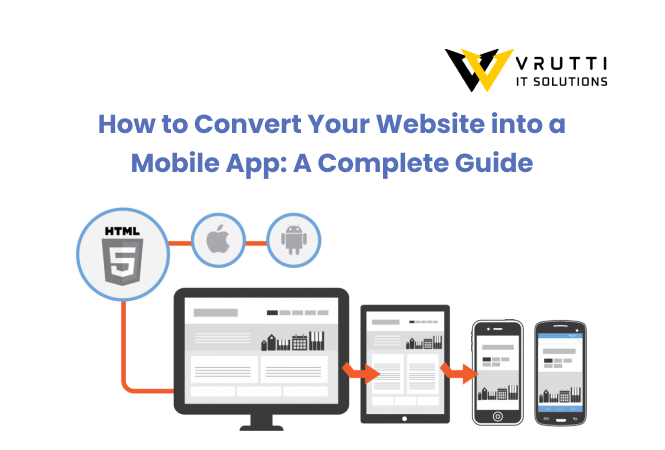How to Convert Your Website into a Mobile App: A Complete Guide

How to Convert Your Website into a Mobile App: A Complete Guide
In today’s digital landscape, having a mobile app for your business is no longer optional—it’s a necessity. If you already have a website and want to expand your reach through a mobile application, the process can be straightforward if done correctly. At Vrutti IT Solutions, we specialize in transforming websites into fully functional mobile applications that enhance user experience and business growth. Here’s a step-by-step guide on how to convert your website into a mobile app.
1. Understand the Importance of API Integration
What is an API?
API (Application Programming Interface) is a bridge that allows different software systems to communicate. When you use an application on your phone, it connects to the internet and sends data to a server, which processes the request and sends it back. This seamless data exchange enables mobile apps to function just like a website but with a more optimized user experience.
Why is API Essential for a Mobile App?
If your website has a database that stores product listings, user accounts, or transactions, your mobile app must connect to the same database through API integration. This ensures real-time synchronization between your website and app, preventing data duplication and inconsistencies.
2. Wireframing and UI/UX Design
Before diving into development, it’s crucial to create a wireframe—a blueprint of your app’s layout. This helps in planning the app structure and avoiding potential design flaws.
UI vs. UX
-
UX (User Experience): Focuses on the functionality and ease of navigation.
-
UI (User Interface): Deals with the visual aesthetics, colors, typography, and animations.
A well-designed UI/UX ensures an intuitive and engaging mobile app that keeps users coming back.
3. Choosing the Right Development Approach
Once the design is finalized, the next step is development. You can choose from three primary approaches:
Native App Development
-
Android: Uses Java or Kotlin.
-
iOS: Uses Swift or Objective-C.
-
Pros: High performance, best user experience, better security.
-
Cons: Costlier and time-consuming.
Cross-Platform Development
-
Flutter (Dart), React Native (JavaScript), Xamarin (C#).
-
Pros: Faster development, cost-effective, single codebase for both Android and iOS.
-
Cons: Slightly lower performance than native apps.
Hybrid App Development
-
Technologies: Ionic, Apache Cordova.
-
Pros: Web-based apps, faster development, cost-effective.
-
Cons: Limited access to native features.
4. Development Process
After selecting the right approach, the development phase begins, which includes:
-
Front-end Development: Creating the user interface and integrating APIs.
-
Back-end Development: Managing database, authentication, and server-side logic.
-
Testing & Debugging: Ensuring the app functions smoothly without any glitches.
5. Testing Your Mobile App
Performing thorough Quality Assurance (QA) testing ensures that your app is stable, secure, and user-friendly. Essential testing methods include:
-
User Experience Testing
-
Functional Testing
-
Performance Testing
-
Security Testing
-
Device and Platform Testing
Testing helps detect and fix potential issues before launch, ensuring a smooth user experience.
6. Deployment & Post-Launch Support
Once your app is ready, it’s time to launch it on the Google Play Store and Apple App Store. This requires a developer account for each platform. After deployment, continuous monitoring and updates are essential to keep your app running efficiently and securely.
Why Choose Vrutti IT Solutions?
At Vrutti IT Solutions, we provide comprehensive mobile app development services, ensuring:
-
Seamless website-to-app transition.
-
Custom UI/UX designs.
-
High-performance, scalable solutions.
-
Ongoing maintenance and support.
If you’re ready to convert your website into a mobile app, get in touch with us today and let’s bring your vision to life!
With the expertise of Vrutti IT Solutions, you can stay ahead in the competitive digital landscape by offering a seamless mobile experience to your users. Contact us now to get started!

